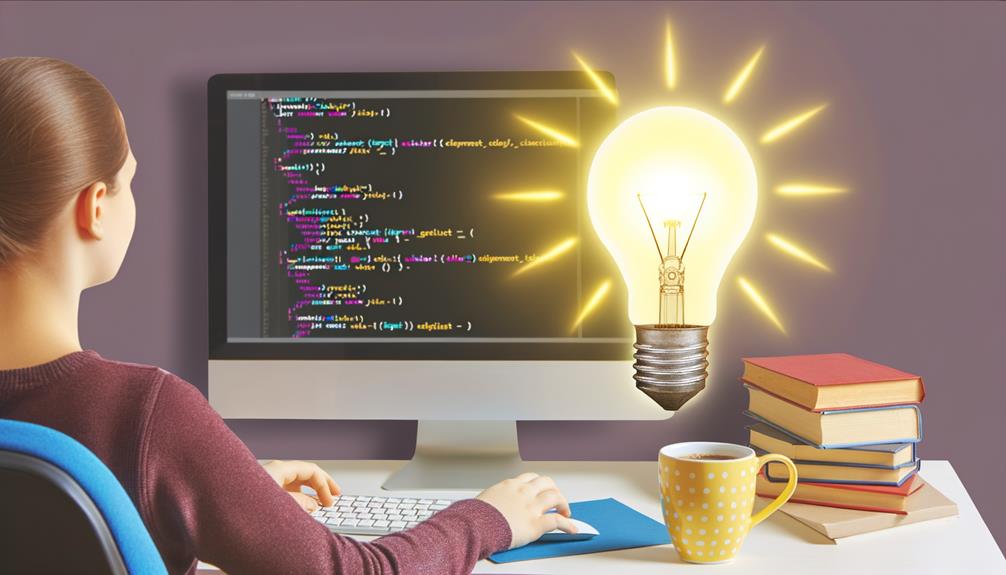The domain of coding, often perceived as daunting, can be navigated with the right resources and guidance. For beginners, understanding the essence of coding and where to initiate their journey is crucial.
This discourse aims to shed light on the fundamental concepts of programming, the relevance of different languages, the role of the internet, and the potential career pathways in coding. As we untangle these components, we’ll also explore the importance of practical coding experiences through hands-on opportunities and interactive platforms.
Stay tuned as we unpack these essential elements and more, setting you on the path to becoming a proficient coder.
Key Takeaways
Understanding Computer Architecture
Diving into the realm of computer architecture, it’s imperative to comprehend that it encapsulates the design and structure of computer systems, including essential components like the CPU, memory, and input/output devices, all of which collaboratively facilitate software-hardware interaction. These core elements and their interconnectedness shape the operating systems, laying the groundwork for the Basics of Programming.
The Central Processing Unit (CPU) performs a pivotal role in executing instructions, performing calculations, and managing the data flow, thereby establishing the foundation for understanding programming concepts. Concurrently, the memory stores data temporarily for quick access by the CPU, an integral part of the intricate dance of software and hardware interaction.
This understanding of the basics is essential to grasp the intricacy of programming, as software intricately interacts with these hardware components to perform myriad tasks. Hence, any aspiring programmer must have a firm understanding of computer architecture to fully comprehend and efficiently use programming languages.
In essence, understanding computer architecture forms the bedrock of software development, and it is a prerequisite for those seeking a sense of belonging in the programming community. It is a stepping stone towards mastering programming concepts and navigating the world of coding effectively.
Basics of Programming Languages
The comprehension of programming language fundamentals is instrumental for any aspiring coder.
Selecting an initial language, often a high-level one such as Python or JavaScript, is a significant step that shapes the trajectory of learning and application.
Grasping the syntax, the governing rules and structure of code writing, is critical to facilitate effective communication with machines and enable robust software development.
Understanding Programming Language Basics
Frequently, successful interaction with computers necessitates a solid grasp of programming language basics, as these languages serve as the crucial medium of communication between humans and machines. As you learn to code, understanding these basics becomes paramount.
Syntax, a fundamental aspect of programming languages, defines the structure and commands that computers comprehend. Each language, from user-friendly Python to more complex Assembly, has its unique syntax and purpose. For example, C# is commonly used for game development, while Java is preferred for Android applications.
Gaining a fundamental understanding of these programming languages and their syntax will equip you with the knowledge needed to effectively instruct computers, thereby enhancing your coding proficiency.
Choosing Your First Language
Selecting an initial programming language, a fundamental decision in one’s coding journey, should ideally be guided by the specific objectives of your intended projects and your personal interest. If you aim to learn programming for web development, JavaScript is essential, enabling interactive websites and dynamic content.
If your interest is in building Android apps or enterprise software, Java offers portability and scalability. For those who wish to start coding for game development or system programming, C++ is known for its efficiency and performance.
Python, on the other hand, is a popular first language due to its readability and versatility in various applications. Each language has its strengths, so your choice should align with your specific goals and personal interest.
Diving Into Code Syntax
After deciding on the appropriate first programming language to learn, it becomes imperative to comprehend the code syntax, a set of rules that defines the structure for writing code in that chosen language.
Grasping the syntax is a critical step in the basics of coding. Master it, and you will be well on your way to becoming a proficient coder.
Internet Functionality Essentials
In the context of programming, understanding the fundamentals of Internet functionality is crucial. Computers communicate over the Internet by transferring data in binary form, a key concept in coding. This forms the basis for creating interactive web pages and dynamic Graphical User Interfaces (GUIs).
The Internet is a global network of interconnected computers, enabling seamless data exchange. Protocols like TCP/IP standardize communication between devices. Mastery of these protocols enhances programming skills, leading to more robust and efficient code.
A solid grasp of Internet functionality is vital in web and software development. In networking, knowledge of data transfer and processing can boost application performance and reliability. In software design, understanding Internet protocols influences decisions when architecting software systems.
Mastering Command-Line Basics

Diving into the realm of command-line basics, it is essential to grasp that the Command-line Interface (CLI) empowers users with the ability to interact with their computer systems through text-based commands, providing a potent means of managing files and executing tasks with remarkable efficiency. The CLI is an integral part of a coder’s toolkit, offering a streamlined approach to programming workflows.
The command-line basics primarily include:
Terminal, Command Prompt, and PowerShell are examples of CLI interfaces on various operating systems. By mastering the CLI, you can interact with your computer more efficiently, execute tasks swiftly, and have better control over your system. This understanding of command-line basics is crucial in the journey of coding, providing a sense of belonging in the programming community.
Enhancing Text Editor Skills
As we progress in our exploration of coding essentials for beginners, we turn our focus to enhancing text editor skills. This involves an understanding of text editor basics, mastering shortcut keys for increased efficiency, and leveraging advanced text editor functions. These elements are crucial for effective coding, as they optimize the development process and facilitate a more streamlined user experience.
Understanding Text Editor Basics
Mastering the basics of text editors such as Sublime Text and Atom is fundamental to enhancing coding efficiency and organization. These essential tools offer a clean workspace for writing and editing code, with features designed to improve your productivity.
Key features include:
Shortcut Keys Mastery
The efficient use of shortcut keys in text editors is a pivotal skill that can significantly expedite coding tasks and improve overall workflow. Keyboard shortcuts, such as Ctrl+C and Ctrl+V, the universal commands for copy and paste respectively, are paramount for coding efficiency. They save time and reduce the need to switch between the mouse and keyboard, thereby enhancing the fluidity of the coding process.
A coder who masters these shortcuts can navigate the text editor with ease, thereby boosting productivity. Regular practice is essential to internalize these shortcuts, turning them into second nature. This mastery fosters a sense of belonging in the coding community, as it is a common language shared among coders and a key to unlocking their potential.
Advanced Text Editor Functions
Building on the foundation of basic text editor skills, a coder’s arsenal can be greatly enhanced by understanding and utilizing advanced text editor functions, such as multi-cursor editing, syntax highlighting, and the use of plugins and packages.
Text editors also offer customization options, enabling you to create an optimal coding environment. By mastering these aspects, you can truly harness the power of your text editor and elevate your coding prowess.
Introduction to HTML and CSS
Diving into the world of web development, one cannot overlook the pivotal role of HTML and CSS, fundamental tools for structuring web content and designing aesthetically pleasing sites respectively. HTML, or Hypertext Markup Language, serves as the backbone of web content, defining the structure of text, images, and videos. This forms the essence of web development, providing the foundation upon which all other elements rest.
CSS, or Cascading Style Sheets, complements HTML by adding style to the web content, enabling developers to control font choices, colors, layout, and overall formatting. It ensures that websites aren’t just functional but visually dynamic, enhancing user engagement and experience.
A thorough understanding of HTML tags and CSS properties is indispensable for creating responsive, user-friendly web interfaces. The precision required in defining these tags and properties emphasizes the analytical nature of front-end development.
Proficiency in HTML and CSS bridges the gap between a beginner and a competent web developer. These languages form the cornerstone of front-end development, shaping the aesthetics and usability of the modern web. Mastering them allows you to belong to the fraternity of developers who are shaping the digital landscape.
Getting Started With Javascript

After mastering HTML and CSS, your journey into the depths of web development would be incomplete without an exploration of Javascript, a versatile and widely-used programming language that imbues websites with interactive elements and dynamic content updates.
JavaScript is the tool that brings your web designs to life. It’s the language that lets you add a myriad of functionalities to your websites, from simple alert dialog boxes to complex games and 3D graphics.
As a beginner, there are three important aspects about JavaScript you should keep in mind:
Embracing JavaScript will not only boost your front-end development skills but also enhance your ability to create dynamic, interactive web experiences. Remember, every step forward in this journey brings you closer to being part of the tech industry. Keep learning, keep growing, and keep coding.
Advancing With Python and Java
Having equipped yourself with a solid foundation in JavaScript, it is essential to broaden your coding knowledge by exploring Python and Java, two powerful languages known for their versatility and applicability in diverse programming paradigms.
Python, a language celebrated for its simplicity and readability, is a popular choice for beginners. Its extensive libraries support a range of tasks, including web development, data analysis, and even artificial intelligence. This makes Python an excellent tool for enhancing your coding skills and broadening your knowledge base.
Java, on the other hand, is a versatile language used widely from mobile apps to enterprise systems. One of its key features is platform independence, which allows programs written in Java to run on any device with a Java Virtual Machine (JVM) installed. This aspect of Java amplifies its applicability and relevance in today’s diverse technological environment.
Frequently Asked Questions
What Are the Basics of Coding for Beginners?
The basics of coding for beginners involve learning coding languages, enhancing problem-solving skills, understanding algorithms, and mastering debugging basics. This foundation fosters efficient data manipulation and provides a platform for advanced programming concepts.
What Should I Know Before I Start Coding?
Before venturing into coding, understanding problem-solving skills, language selection, and coding ethics is crucial. Consider your time investment, as mastery requires consistent learning. These insights provide a roadmap to navigate the thrilling coding journey.
What Do You Need on Your Computer as a Coding Beginner?
As a coding beginner, your computer needs to meet certain hardware requirements and have the ideal operating system. Necessary coding tools include a text editor or IDE and relevant software. Software selection depends on your coding language.
Can I Teach Myself to Code?
Yes, self-learning to code is viable through online resources and project-based learning. Effective time management strategies and consistent practice are essential. Joining coding communities can further enhance your learning experience and foster a sense of belonging.
Conclusion
In conclusion, mastering coding essentials is a critical step towards becoming proficient in computer programming. The journey begins with understanding computer architecture, mastering command-line basics, enhancing text editor skills, and familiarizing oneself with essential programming languages such as HTML, CSS, Javascript, Python, and Java.
Will not these foundational skills pave the way for a promising career in coding? Indeed, the ability to code is a prized skill in today’s digital world, opening doors to numerous opportunities.


